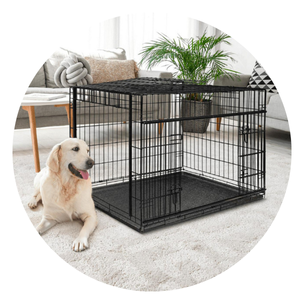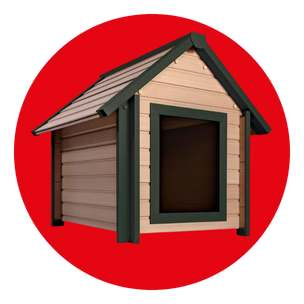What crate is best for crate training a puppy?
+
For most puppies, a wire dog crate with a divider panel is ideal for crate training. Wire crates are sturdy, well-ventilated, and you can adjust the living space with a divider as your puppy grows. This way, you start with a smaller area (to discourage the pup from using one end as a toilet and the other as a bed) and gradually expand it. Make sure the crate is just large enough for the puppy to stand up, turn around, and lie down—any larger and your pup might treat one corner as a bathroom. Add soft bedding and introduce the crate in a positive way (treats and praise) so your puppy sees it as a happy space. With consistency, a wire training crate becomes an excellent tool to help with housebreaking and creating a safe “den” for your puppy.
How do I choose the right size crate for my dog?
+
Sizing is very important—a crate should be big enough for your dog to stand, turn around, and lie down comfortably, but not much bigger. If the crate is too small, your dog will be cramped; too large, and it won’t feel secure (and a puppy might use one end as a toilet). To choose the size, measure your dog’s length from nose to base of tail and height from floor to top of head. For adult dogs, select a crate a few inches taller and longer than their dimensions. If buying for a puppy, estimate their adult size (breed charts help) or get a crate with a divider so you can adjust the space. Remember, dogs feel safest in a cozy but comfortable space—they should be able to stretch out, but a crate isn’t meant to be a playpen. When in doubt, it’s okay to size up slightly for an adult dog and just add more bedding to make it cozy.
Are your dog crates IATA approved for air travel (and what are the rules)?
+
Yes, we carry IATA-approved dog travel crates for airline use. IATA (International Air Transport Association) sets the standards that most airlines follow for pet travel kennels. An IATA-compliant crate must be a rigid, secure container, typically made of strong plastic or fiberglass with a metal door, and have ventilation on all four sides. The crate needs a secure locking mechanism (most have a metal grate door with a latch that can be zip-tied shut) and no openings that a pet could squeeze through or paw/nose get stuck. Additionally, the crate should be tall enough for your dog to stand without ears touching the ceiling and wide enough to turn around. Airlines also require attachable water/food bowls and absorbent bedding inside. No wheels are allowed on the crate during flight (if the crate has wheels, they must be removed). Always double-check with your specific airline, but rest assured that our travel crates labeled “IATA approved” meet the general requirements for international pet travel. We’re happy to advise on the best size and model for your dog and destination.
Which is better: a soft fabric crate or a hard plastic crate?
+
It depends on your needs. Soft-sided crates (fabric or nylon ones) are lightweight, portable, and easy to store. They fold down and are great for travel by car or for temporary indoor use (like at a hotel or when visiting friends). Dogs often find them cozy, and many models have mesh windows for ventilation. However, soft crates are not as sturdy—a determined dog or a chewer can eventually tear the mesh or fabric, and they’re not ideal if your dog isn’t fully crate-trained or tends to escape. Hard plastic crates, on the other hand, are more robust and secure. They’re the type you see for air travel or trips to the vet. Plastic crates have solid walls (great for dogs who like a more den-like, enclosed feel) and usually a metal door. They’re easy to clean (important if a pet has an accident) and durable. The trade-off is that they are bulkier and less ventilated than wire or soft crates. In summary, use a soft crate for convenience and calm dogs on the go, but choose a hard plastic crate for maximum security, especially for travel or if your dog is an escape artist. Some pet owners even have both—a soft crate for road trips and a plastic or wire crate at home.
What are some tips for crate training my dog?
+
Start slow and make the crate a positive place. Begin by introducing your dog to the crate with the door open, toss in a few treats or a favorite toy so they go in on their own. Feed your dog’s meals inside the crate to build a happy association. When you start closing the door, do it for very short periods while you’re nearby, and gradually extend the time. Always praise your dog and reward them for calm behavior in the crate. Never use the crate as a punishment—it should feel like a safe den, not jail. Maintain a routine: for example, crate your dog at bedtime or when you go out for short errands, so they get used to it as part of daily life. Make sure the crate is comfy: add soft bedding (unless they’re prone to chewing it) and maybe an item of your clothing for your scent. If the dog is anxious, cover part of the crate with a blanket to create a more den-like atmosphere (but ensure it’s still ventilated and not too hot). Consistency is key—some whining at first is normal, but don’t give in too quickly or they’ll learn that whining gets them out. Instead, reward quiet, calm behavior. With patience and positive reinforcement, most dogs come to love their crates as a personal space. Done properly, crate training can reduce anxiety and destructive behavior by giving your dog a safe spot to relax. If you need more help, check out our Puppy Accessories and Training Aids for tools that can assist with crate training (like calming pheromone sprays or chew toys to keep them busy).
How do I choose an outdoor dog kennel for my garden?
+
When picking an outdoor kennel (dog house), consider size, material, and placement. Size is number one: your dog should be able to enter, turn around fully, stand, and lie down comfortably in the kennel. It shouldn’t be too tight, but also not overly large—dogs feel cozy in a space that’s just right for their body, and in cooler weather, a properly-sized kennel will retain your dog’s body heat better than an oversized one. Measure your dog’s length and height and choose a kennel a bit larger than that (for example, many use the formula of about 1.5 times your dog’s length for the kennel’s depth/width). Next, look at materials: wooden kennels are popular and naturally insulating, many have felt-lined or waterproof roofs to keep rain out. Plastic kennels are lightweight and waterproof as well, though may need added insulation for winter. Some deluxe models have insulation layers or raised floors. Think about Ireland’s weather: you’ll want something waterproof, windproof, and perhaps slightly elevated off the ground to avoid dampness. Finally, placement is key. Put the kennel in a protected area of your garden, somewhere that’s not in direct wind or sun. For instance, against a house wall or under a porch or tree can provide extra shelter. Make sure the entrance isn’t facing the prevailing wind. You can add a door flap or windbreaker panel to the kennel entrance for winter months to keep drafts out. And don’t forget to make it comfy: add straw, blankets, or a kennel-specific bed, and clean it regularly. With the right kennel, your dog can enjoy the outdoors while having a snug refuge whenever they want.








